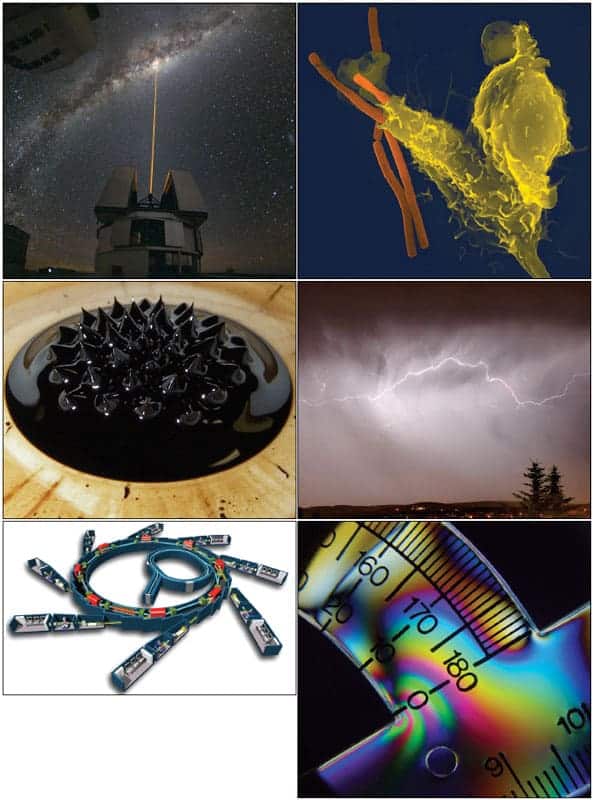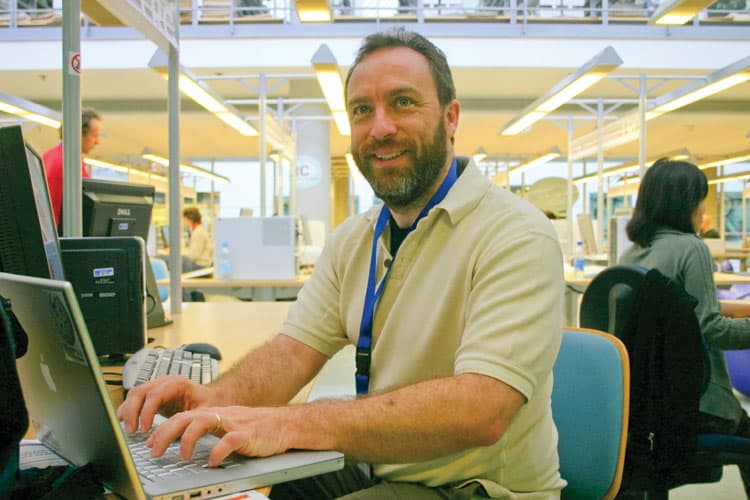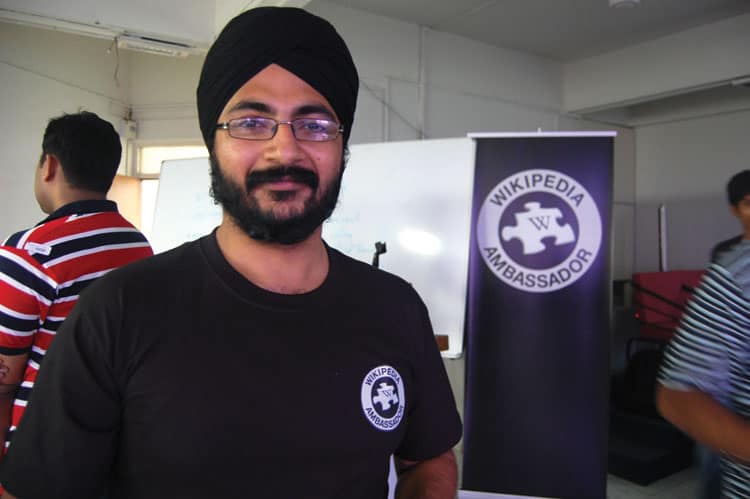If you have knowledge you can share, Wikipedia needs you. Get your students involved too – improving articles is a great educational opportunity, argue Martin Poulter and Mike Peel

In a 1992 article for Physics World, Tim Berners-Lee wrote about the difficulties of managing the explosion of information available through his new invention, the World Wide Web. He saw that while easy, global online publishing would bring many benefits, users would be overwhelmed by huge numbers of documents. Electronic publication was also blurring the traditional lines between academic work and personal opinions. Users would need overviews of each area of knowledge, with reviews to help them assess the reliability of what they read. This would have to happen on a network with no central control. In short, what people really needed was a Web of knowledge, not just of information.
Berners-Lee saw that the Web needed an encyclopedia. This would be “An attempt by the knowledgeable, the learned societies or anyone else, to represent the state of the art in their field. [It] will be a living document, as up to date as it can be, instantly accessible at any time.” Nearly 20 years on, it is time to revisit the idea of organizing the world’s knowledge. Wikipedia, the free online encyclopedia that anyone can edit, has become the fifth most visited site on the Web, with nearly half a billion visitors per month. It fits Berners-Lee’s description, but is still (and always will be) a work in progress.
This article looks at two developments. Having established itself as the largest reference work ever created, Wikipedia is looking to be ever more reliable and detailed in what it covers. This involves collaborating with scholarly communities, including the Institute of Physics (which publishes Physics World), and individual educators or researchers. If you want to inform and excite the public about the techniques and discoveries of your favourite area of physics, Wikipedia is a way to reach the greatest audience.
Additionally, although a great many articles are incomplete, this is increasingly being seen as an educational opportunity. Some university courses have started to assign students the task of improving Wikipedia articles. This process encourages some very good habits, such as proper sourcing of statements and respectful collaboration with others. The same opportunity is open to anybody with the right skills. If you can look up facts; summarize, structure or illustrate them; and make them understandable to other people, then Wikipedia needs you.
Free for all
Wikipedia is the best known of nine online projects run by the Wikimedia Foundation, a US-based charity. Each of them serves a different educational or reference need. For example, people can look up Richard Feynman’s witticisms on Wikiquote or define “attophysics” on Wiktionary. Each project is multilingual: Wikipedia itself is currently being written in 270 different languages. As the names suggest, all of these projects are based on a type of software called a “wiki”. This gives each page an edit button so that a site’s readers can rapidly make changes.
It is an unusual publishing enterprise, not least because it depends on volunteer labour. The roughly 100,000 regular contributors all work for no pay, because they believe in the shared goal of creating “a world in which every single human being on the planet is given free access to the sum of all human knowledge”. As well as the writing, all of the editing and reviewing is done collaboratively by volunteers.
The projects also differ from traditional publishing in that they provide free content. This is “free” not just in the sense of “for no money” but also in the sense of free speech. All the content is available under “copyleft” licences that guarantee the users’ right to copy, modify and redistribute, given certain conditions. So while most sites on the Web would not be happy with you taking their images or video for your own site or publication, anyone can reuse content from the Wikimedia projects, so long as they obey the licence conditions. These vary, but usually involve fully crediting the original source. The entire text of Wikipedia, and the software it runs on, can be taken and copied onto other media, again so long as the original source is credited.
Wikipedia does not accept original research; that has to be published and critically examined in the usual way in peer-reviewed journals. The function of Wikipedia (or any encyclopedia) is to give overviews of subjects in language that a layperson can understand. Different readers want different amounts of information, and Wikipedia‘s structure reflects this. Someone who wants a quick overview of what is known about stars can read the summary paragraphs at the top of the “Star” article. If they want more detail, they can read the full article and follow links to sub-articles such as “Stellar evolution”, “Neutron star” and then even to specific noteworthy neutron stars. All of these articles cite published sources, so that readers can check the facts for themselves. In this way, the encyclopedia serves a “pre-research” function, satisfying the curiosity of laypeople while driving experts to the most relevant sources for a specific topic.
Subject matter
Wikipedia‘s 3.7 million articles in English are backed by other pages such as policies, guidelines, user profiles and noticeboards. Though not part of the encyclopedia, these are also open for the public to view and edit. These pages include WikiProject Physics, a shared space for contributors – some expert, some amateur – who improve articles on the subject. On the WikiProject Physics discussion pages, they review articles, share tasks and ask for advice.
The wikiproject reviews and monitors about 14,000 articles with some relevance to physics. The 80 most popular of these are each getting more than a million hits per year. All you can assume about the readers of English Wikipedia is that they know English – not necessarily at a high level – so a lot of effort is put into making the encyclopedia not just technically correct but also accessible to people with no background in physics. Sometimes this takes the form of dedicated overview articles such as “Introduction to special relativity”. The extreme end of this drive for accessible explanations is the Simple English Wikipedia, written in a restricted vocabulary for learners of English around the world. Roughly 150 of its articles are on physics, including heroic attempts to explain terms such as “frame-dragging” and “negentropy”.
At their best, Wikipedia articles ignite curiosity as well as satisfying it. While being neutral and accurate, they also draw the reader in and show them why the topic is worth knowing about. That involves using not only engaging text, but also images, video clips, tables, equations and formulae, and of course references. The “free content” requirement means that Wikipedia cannot just take any image or video from the Internet – they need to be freely licensed or out of copyright. Photographs, diagrams, animations and video are all collected on, and curated by, its sister project Wikimedia Commons (see images at top of this article). Many of these files are uploaded by researchers, scientific bodies or educational projects. These files also include lecture videos – for example, the Massachusetts Institute of Technology has shared clips of Walter Lewin’s physics lectures.
Articles on a common theme can be organized into what is called a Wikipedia Book, which can be downloaded as a print-quality file. The books relating to physics include one on Isaac Newton and another about the Large Hadron Collider. As the overall quality of Wikipedia articles improves, this raises the prospect of highly specific textbooks customized to individual educational courses.
Drive for quality
WikiProject Physics, and the Wikipedia community generally, are working to drive articles to ever higher levels of quality. The site’s status as the largest ever encyclopedia is only a step towards the eventual goal of assembling a complete overview of human knowledge. Improvement takes the form of a repeating cycle of editing and reviewing. Whether a change remains or is undone by another editor often comes down to the quality of the sources. For example, if you add a fact that is cited to a peer-reviewed journal, that will probably remain, though anyone is welcome to improve the phrasing or structure. Statements based on a self-published source, such as a personal blog, are much more likely to be replaced or deleted.
Evaluating the quality of articles is one of the crucial activities going on behind the scenes of Wikipedia, and one of the ways it depends on respectful collaboration. There are multiple stages of review, at each of which the article is checked against specified criteria. Some criteria are straightforward, such as the correct capitalization of headings. Other contributors require a good knowledge of the published works on a given subject so that they can assess whether an article is complete and well written. Although Wikipedia does not give any special status to qualified users, experts have a real practical advantage because of their knowledge of the scientific literature.
As articles are developed, they can be given various ratings. Most begin as a stub (figure 1a), which includes a definition and some basic facts but no references. A few ratings above this is the C-class article, an example of which is “Hydrogen spectral series”. This has a lot of sourced material and tables but is a list of facts rather than an accessible overview of the topic. An article that has been confirmed as well written, factually accurate, broad, neutral, stable and illustrated can be labelled a good article, an example of which is “Weak interaction”. Only about 0.5% of Wikipedia‘s content is at or above this level. The criteria for a featured article are even more demanding (figure 1b). This label is awarded to articles that are “professional, outstanding and thorough”, meeting a long list of style requirements. The 44 current featured articles in physics include “Supernova”, “Atom”, “General relativity”, “Uranium” and “Magnetosphere of Jupiter”. Articles at this level can appear on the front page of the site as “Today’s Featured Article”. This happened to “Gamma-ray burst” on 18 June 2011. As a result, five million people saw the one-paragraph summary on the front page, and 32,000 of them followed the link to the full article. This shows how, through Wikipedia, scientific ideas and theories can access a readership in one day that pages on many other sites would struggle to reach in a whole year.
There are many ways to get involved in improving Wikipedia (see box). Some of the biggest contributions are made not by people writing articles, but by research groups or archives that give permission for collections of images to be reused.
Educational projects
We in the Wikipedia community have set ourselves a truly enormous task: to write high-quality, accessible articles on every area of knowledge. The estimated 100 million person-hours achieved in the first decade are only a start. Meanwhile, educators in schools and universities want to create experiences that encourage critical thinking, collaboration, proper use of sources and other good scholarly habits. Perhaps these problems can solve each other if educators and Wikipedians work together.
That is the thinking behind Wikipedia educational assignments. Students or school classes work with each other and with the Wikipedia community to create or improve articles or specific items such as graphs, timelines or diagrams. The wiki software records their contributions and instructors assess their work. The first university assignments focused on articles about public policy. For example, the extensive article “Nuclear energy policy in the United States” was written by Kasey Baker, a graduate student, in collaboration with Wikipedia volunteers. This opportunity has now been thrown open to all subjects. Thousands of students, at universities on four continents, are now improving Wikipedia for course credits.
Thousands of students, at universities on four continents, are now improving Wikipedia for course credits
Students who are working on undergraduate projects, or are beginning postgraduate work, are the ideal people to benefit. They already have to create neutral, well-sourced reviews of the existing literature, which is just what Wikipedia needs. The site is also an excellent self-study opportunity. For someone who is no longer a student and wants to extend their knowledge, improving a Wikipedia article and submitting it for review is a way to get independent feedback.
The above-mentioned quality scale can be used to guide assessment of students’ work, although a more finely grained scale has been created specifically to help instructors. The students see their work being published online for a global audience, perhaps becoming more widely read than their own tutors. This exposure, and the prospect of their work being evaluated by strangers, can motivate students to work especially hard. One university professor remarked that this was the first assignment in which students took a keen interest in the library. A downside is that students might experience stage fright when taking their first steps. This can be handled by creating the first drafts elsewhere, perhaps in a virtual learning environment, and adding them to Wikipedia once they have been checked.
Wikipedia provides two kinds of help for educational assignments. Campus ambassadors are trained to work with staff and students in person, giving them the confidence to use the site. Online ambassadors are experienced Wikipedians – perhaps geographically remote – who monitor and support the students’ contributions. With this volunteer help, which is available if you get in touch with us, instructors and students can take part without having to learn every little detail of Wikipedia.
Wikipedia‘s sister projects can also assist education. Wikibooks is another project that invites educational assignments from universities and schools. Unlike Wikipedia, it is not constrained to an encyclopedic style: it allows “how to” books or textbooks, so classes can be set the task of actually writing the textbook for their course. Wikiversity hosts a variety of educational resources and course pages.
In summary, Wikipedia and its related projects have an ambitious goal that we believe is worth pursuing in its own right. Berners-Lee saw that the Web was incomplete without a global, comprehensive, up-to-date encyclopedia. This is what the Wikipedia community is working to provide. If you have access to books about physics, you can help, even in a small way. We can testify that it is rewarding work that develops your knowledge of the subject, while potentially reaching an audience of millions. Clicking the edit button is just the first step.
Box: Get involved
In addition to writing and improving Wikipedia articles, there are many other ways to contribute.
- Translate high-quality articles into other languages
- Review articles and suggest improvements
- Contribute to discussion pages and noticeboards
- Share files such as images, animations and video clips
- Meet up with other interested people to share tips
- Keep an eye on articles and watch for attempts to vandalize them
If you have an idea that needs some money to get off the ground, get in touch with your local Wikimedia chapter, which in the UK is Wikimedia UK.






